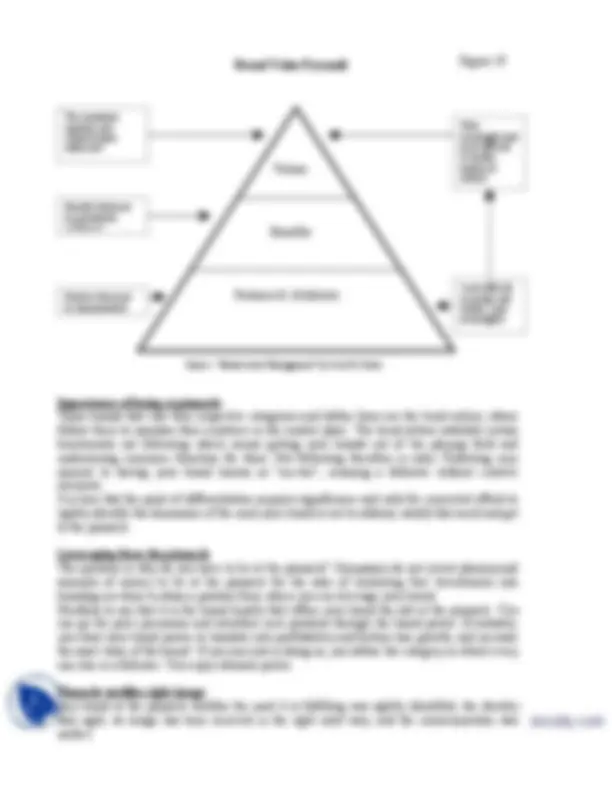




Study with the several resources on Docsity

Earn points by helping other students or get them with a premium plan


Prepare for your exams
Study with the several resources on Docsity

Earn points to download
Earn points by helping other students or get them with a premium plan
Community
Ask the community for help and clear up your study doubts
Discover the best universities in your country according to Docsity users
Free resources
Download our free guides on studying techniques, anxiety management strategies, and thesis advice from Docsity tutors
The concept of brand image, which is composed of brand associations and persona. Brand associations refer to the benefits and attributes a brand offers to consumers, while persona is the human characteristics of the brand. How features and attributes translate into perceived benefits and how benefits are weak unless they relate to customers' central values. The document also includes examples and illustrations to help understand the concept of laddering up the attributes and perceived benefits. The objective is to help businesses better understand their brand's strengths and weaknesses and have realistic strategic goals.
Typology: Exercises
1 / 4

This page cannot be seen from the preview
Don't miss anything!



Lesson 10 BRAND PICTURE Brand picture is based on brand image, which has two following components:
Source: “Brand Asset Management” by Scot M. Davis Figure 17
The concept of laddering up the attributes and perceived benefits can be explained with the help of the following set of three related examples: Example 1 Think of a brand of clothing that you may not buy but do think is worth considering. The reason you think it is worth the space on the market is that it does demonstrate certain features and attributes that may have appeal for some, if not you. The brand is out in the market fulfilling need of a certain segment that has to be addressed by some brand(s). Example 2 Think of another brand of clothing that you desire just to fulfill certain basic needs with no intention for self-fulfillment. You expect the brand to offer you basic benefits and feel satisfied. You do not feel the need for projecting yourself. Your concern is all about the functional benefit that the brand provides. Consider a basic sport shirt in the light of this example. Example 3 Think of the best possible brand of clothing with which you associate yourself the most. If it rings a chord with your emotional values and beliefs, then it is laddered up in your mind to the highest. Your values dictate that you must look different by way of having expensive and fashionable clothing and be able to project yourself as a modern, sophisticated person. What happens is that you start feeling very important and confident thinking you are projecting the image you deserve. The laddering up of benefits can be explained wit the help of the following graphic illustration: Features refer to demonstrable features and attributes that fulfill basic needs. In the second stage, features and attributes translate into benefits, while in the third stage customer values are also fulfilled along with benefits. Refer to extra-curricular activities offered by a school with a good education system. The concept can be summarized in the following words:
Figure 18
From pinnacle to bottom There are categories in which all players work hard to win over customers by offering points of difference with quality. The offerings eventually get so close to each other that they lose the charm of having had differentiation at one point, thereby reducing the whole category to basic features and attributes. What once was a differentiated feature offering unique benefits and values is now commonplace and hence calls for working all over again through the brand value pyramid. The renewed working may not mean changing the product all together. It could be done through various ways of offering meaningful value to the customer, like improving service, distribution, and management practices. Toyota Corolla is an excellent example under such circumstances. Its direct competitors offer everything in tangible terms in their models, and yet Toyota is right on top. The position owes to the unmatchable customer value the brand offers through better availability of spares, service, and resale price of cars. The extra meaningful value does not let Toyota lose its exceptional laddering and reduce the model to the first level of brand pyramid. Conversely, in many cases of consumer consumables, similarities let brands catch up with each other and prevent them from offering any meaningful ways of retaining differentiated customer value. The result is all brands lose their exceptional laddering and reduce the category to the first level of brand pyramid. Price wars and massive promotions start. Result is shake-outs. Category gets a new life with the advent of new technology or at least new innovation or a substitute category of products. The next lecture continues with the levels of association a good brand should evoke. How features and benefits should be determined to have the desired associations evoked is the starting point of the lecture. Bibliography:
_1. Scot M. Davis: “Brand Asset Management – Driving Profitable Growth through Your Brands”; Jossey-Bass, A Wiley Imprint (54)